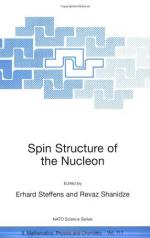|
This section contains 496 words (approx. 2 pages at 300 words per page) |

|
Protons and neutrons, the components of the atomic nucleus, are both classified as nucleons. Protons carry a positive electric charge, while the neutron is electrically uncharged, but they display the same behavior in their strong force interactions. These particles are classified as nucleons even when they are not inside an atom. Except for hydrogen, whose nucleus is composed of a single proton, all atomic nuclei consist of a combination both types of nucleons. The nucleons are the most stable hadrons, that is, particles affected by the strong nuclear force. Protons are so stable that they have never been observed to decay and they are believed to be stable for the entire lifetime of the universe. Although a free neutron decays to form a proton, an electron and an anti-neutrino in about 15 minutes, neutron bound in an atomic nucleus are stabilized and usually do not decay.
The mass of...
|
This section contains 496 words (approx. 2 pages at 300 words per page) |

|


